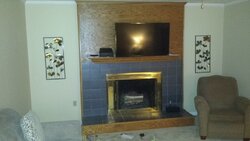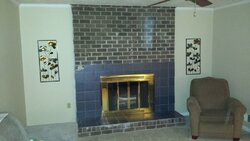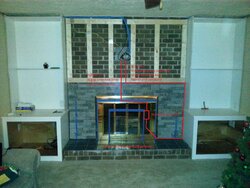Hi, I'm new to Hearth.com, but have read many threads on here. The first half of this post talks of the surround and hearth, but I'll also be asking about putting in a fireplace insert.
We've been living in our new 1975 house for about 6 months now, and my wife and I couldn't stand the look of our fireplace:

We were pretty sure there was brick under the tile and plywood, so we decided to just tear it off, just a few hours ago, thinking that the brick is probably in pretty good shape and we could undo the horrible damage the previous owners had done by covering up perfectly good brick:

The plywood above the mantel came off great with just a little adhesive remaining, but after spending 5 minutes to get one tile off, and not having much luck getting the thinset off, our hopes were dashed. We can't easily recover the bricks, at least from the lower half.
So I think I have a plan, and wanted to get your take on it.
Once that's done, it will look pretty great, but won't function so well. When we bought the house, the chimney inspector found about a 1.5 inch chip in the 13x13" terracotta tile, about 2/3rds up the 18 foot flue, and suggested not using the fireplace until repaired. We also know how terribly inefficient open fireplaces are, and so are looking at an insert. We have two above grade levels and a basement, with each level around 1100 sq ft, so 3300 sq ft total. We have the chimney protruding through an exterior wall. The fireplace opening is about 35" wide and 29" high and 25" deep. We have a heat pump, and are looking to just supplement heat a bit in the coldest months, and to enjoy the warm and flames of the fire, and to give myself an excuse to gather firewood.
So here's my plan for the fireplace itself:
We've been living in our new 1975 house for about 6 months now, and my wife and I couldn't stand the look of our fireplace:

We were pretty sure there was brick under the tile and plywood, so we decided to just tear it off, just a few hours ago, thinking that the brick is probably in pretty good shape and we could undo the horrible damage the previous owners had done by covering up perfectly good brick:

The plywood above the mantel came off great with just a little adhesive remaining, but after spending 5 minutes to get one tile off, and not having much luck getting the thinset off, our hopes were dashed. We can't easily recover the bricks, at least from the lower half.
So I think I have a plan, and wanted to get your take on it.
- Leave tile in place, scuffing it up with a belt sander, and adding AirStone or another stone veneer on top of the tile on the wall, and on top of the brick along the edge of the hearth.
- Put some kind of stone-like material on top of the hearth tile, or perhaps even another type of tile. Suggestions are eagerly welcomed here.
- Reuse and paint the old mantel white. Perhaps cover the top bricks with plywood painted white; this part is one where I'm not sure exactly what I want to do.
- In the future I'd like to add some built in cabinets and shelves on either side.
Once that's done, it will look pretty great, but won't function so well. When we bought the house, the chimney inspector found about a 1.5 inch chip in the 13x13" terracotta tile, about 2/3rds up the 18 foot flue, and suggested not using the fireplace until repaired. We also know how terribly inefficient open fireplaces are, and so are looking at an insert. We have two above grade levels and a basement, with each level around 1100 sq ft, so 3300 sq ft total. We have the chimney protruding through an exterior wall. The fireplace opening is about 35" wide and 29" high and 25" deep. We have a heat pump, and are looking to just supplement heat a bit in the coldest months, and to enjoy the warm and flames of the fire, and to give myself an excuse to gather firewood.
So here's my plan for the fireplace itself:
- Install a 6" steel liner, squashing it a bit to fit through the 6" opening in the damper, as the liner is actually 6.25". Because we have an exterior chimney, we'd insulate the liner with blanket insulation.
- As we intend to use this more for enjoyment than a primary heat source, get a smaller, inexpensive fireplace insert like the Century one from Northern Tools or the Englander 13-NCI.



